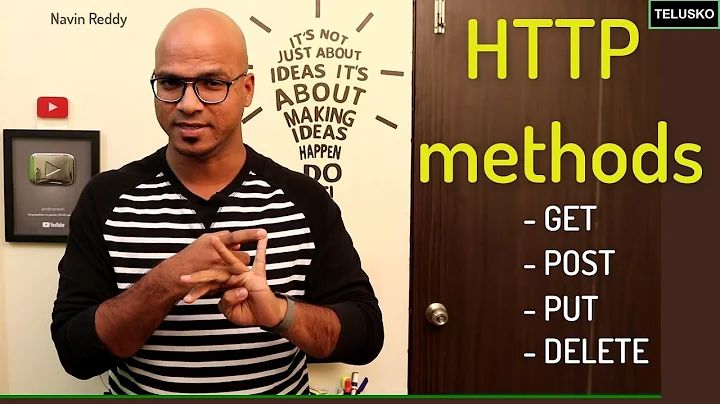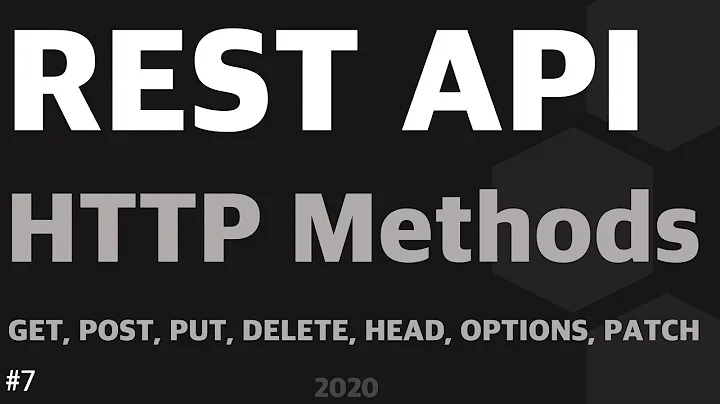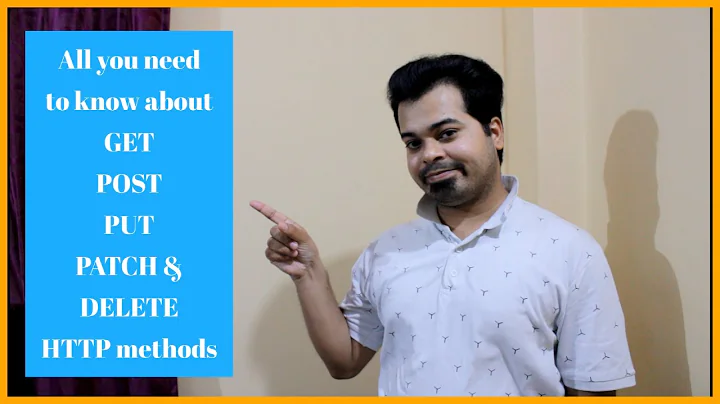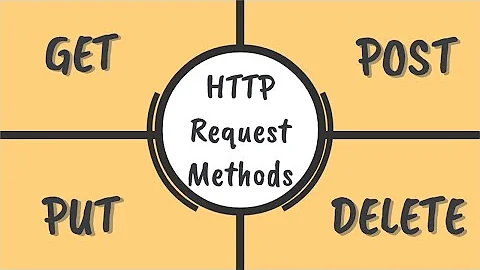Which HTTP methods match up to which CRUD methods?
Solution 1
Create = PUT with a new URI
POST to a base URI returning a newly created URI
Read = GET
Update = PUT with an existing URI
Delete = DELETE
PUT can map to both Create and Update depending on the existence of the URI used with the PUT.
POST maps to Create.
Correction: POST can also map to Update although it's typically used for Create. POST can also be a partial update so we don't need the proposed PATCH method.
Solution 2
The whole key is whether you're doing an idempotent change or not. That is, if taking action on the message twice will result in “the same” thing being there as if it was only done once, you've got an idempotent change and it should be mapped to PUT. If not, it maps to POST. If you never permit the client to synthesize URLs, PUT is pretty close to Update and POST can handle Create just fine, but that's most certainly not the only way to do it; if the client knows that it wants to create /foo/abc and knows what content to put there, it works just fine as a PUT.
The canonical description of a POST is when you're committing to purchasing something: that's an action which nobody wants to repeat without knowing it. By contrast, setting the dispatch address for the order beforehand can be done with PUT just fine: it doesn't matter if you are told to send to 6 Anywhere Dr, Nowhereville once, twice or a hundred times: it's still the same address. Does that mean that it's an update? Could be… It all depends on how you want to write the back-end. (Note that the results might not be identical: you could report back to the user when they last did a PUT as part of the representation of the resource, which would ensure that repeated PUTs do not cause an identical result, but the result would still be “the same” in a functional sense.)
Solution 3
I Was searching for the same answer, here is what IBM say. IBM Link
POST Creates a new resource. GET Retrieves a resource. PUT Updates an existing resource. DELETE Deletes a resource.
Solution 4
Right now (2016) the latest HTTP verbs are GET, POST, PATCH, PUT and DELETE
Overview
- HTTP GET - SELECT/Request
- HTTP PUT - UPDATE
- HTTP POST - INSERT/Create
- HTTP PATCH - When PUTting a complete resource representation is cumbersome and utilizes more bandwidth, e.g.: when you have to update partially a column
- HTTP DELETE - DELETE
Hope this helps!
If you are interested on designing REST APIs this is an ansewome reading to have! website online version github repository
Solution 5
There's a great youtube video talk by stormpath with actually explains this, the URL should skip to the correct part of the video:
Also it's worth watch it's over an hour of talking but very intersting if your thinking of investing time in building a REST api.
Related videos on Youtube
Drew
Updated on September 04, 2020Comments
-
Drew over 3 years
In RESTful style programming, we should use HTTP methods as our building blocks. I'm a little confused though which methods match up to the classic CRUD methods. GET/Read and DELETE/Delete are obvious enough.
However, what is the difference between PUT/POST? Do they match one to one with Create and Update?
-
Donal Fellows almost 13 yearsPUT and POST don't match exactly to either Update or Create; PUT is “set” (i.e., where you know the resource name beforehand and are giving the value to use) and POST is everything else. The key is to think about whether what you are doing is idempotent or not.
-
stand almost 13 years+1 on the comment. The assumption of an absolute mapping between the two can be misleading. An HTTP DELETE operation to some URI, for example might simply modify (i.e. UPDATE) a server side record so that an HTTP GET operation on no longer returns a representation.
-
Jim Ferrans almost 13 years+1: The distinction you make between PUT to create resources whose names (URIs) are assigned by the client and POST to create resources whose names are assigned by the server is important. See Richardson and Ruby's Restful Web Services (O'Reilly) for a discussion on it.
-
Jim Ferrans almost 13 yearsAnd since PUT and DELETE aren't yet supported by web browsers, it's considered okay to "overload POST" by adding a query string argument like method=PUT or method=DELETE on the URI being POSTed.
-
Piotr Dobrogost over 12 yearsPUT and POST don't match exactly to either Update or Create. True but AJ described what pattern he uses.
-
 Boris Ivanov almost 12 yearsNice analyses jcalcote.wordpress.com/2008/10/16/…
Boris Ivanov almost 12 yearsNice analyses jcalcote.wordpress.com/2008/10/16/… -
eis about 11 years@JimFerrans PUT and DELETE are supported by web browsers just fine, with XHR. However, in the context of HTML forms, HTML specification doesn't support them so browsers can't either.
-
bh5k about 11 yearsHere is a link where Martin Fowler discusses the Richardson Maturity model and summarizes it quite well: martinfowler.com/articles/richardsonMaturityModel.html
-
Toddius Zho almost 11 yearsWhile not canonically mapping to a letter in CRUD, a lot of REST frameworks also use GET /entity/ to List entities of type entity. GET /entity/id will read the particular entity matching the id.
-
Les Hazlewood almost 11 yearsPUT and POST can BOTH be used for Create and Update. I cover this here: youtube.com/watch?v=hdSrT4yjS1g&t=18m12s I also cover idempotency mandates. I hope this is helpful!
-
Lawrence Dol over 10 yearsUsing POST for an update allows the caller to provide a partial list of properties, being one the ones they want to update.
-
 Trevor over 10 yearsUpdate could also correspond to PATCH, which should represent a partial update (e.g. a single attribute on an entity). Note: support for PATCH is a bit spotty; not all server software has implemented this HTTP method.
Trevor over 10 yearsUpdate could also correspond to PATCH, which should represent a partial update (e.g. a single attribute on an entity). Note: support for PATCH is a bit spotty; not all server software has implemented this HTTP method. -
 Admin about 10 yearsWhat about GetAll(), GetRange()? Say you have controller with GET() POST() PUT() DELETE() methods /entity = GetAll() /entity/1 = Get(1) /entity/0/10 = GetRange(0,10) (from index 0 return 10 more)?
Admin about 10 yearsWhat about GetAll(), GetRange()? Say you have controller with GET() POST() PUT() DELETE() methods /entity = GetAll() /entity/1 = Get(1) /entity/0/10 = GetRange(0,10) (from index 0 return 10 more)? -
Polykrom about 10 yearsdalu check out stackoverflow.com/questions/6190323/… for an answer to your question.
-
 Sebastian Barth over 9 yearsWhat about the other methods like PATCH and HEAD? Aren't they a part of REST?
Sebastian Barth over 9 yearsWhat about the other methods like PATCH and HEAD? Aren't they a part of REST? -
 zerobandwidth over 8 yearsThis distinction between the use cases for
zerobandwidth over 8 yearsThis distinction between the use cases forPOSTandPUTis an interesting one, and should make the answer to "Which is 'create' and which is 'update'?" that much clearer. Further, with regards to the implementation of the API, it would follow that a repetitivePUTshould amount to a silent no-op, whereas a repetitivePOSTmight throw an exception if some aspect of the data being sent is supposed to remain unique in the data store that backs the application. -
Martin Spamer about 8 yearsThis answer & following comment raise an important point, that caution should be exercised in equating CRUD to closely (1to1) with HTTP REST semantics. This is not a canonical mapping.
-
Dizzley about 6 yearsAs of Feb '18, be aware that PATCH is not thoroughly implemented in client and server libraries.
-
 d1jhoni1b about 6 yearsoh ok thanks i see...would you mind to post a link/reference so i can take a look please?
d1jhoni1b about 6 yearsoh ok thanks i see...would you mind to post a link/reference so i can take a look please? -
cowlinator over 5 years@osullic, I believe the distinction between a partial update and a full update is that a partial update modifies the existing resource, while a full update discards and replaces the existing resource.







